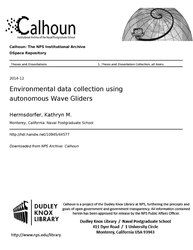File:Environmental data collection using autonomous Wave Gliders (IA environmentaldat1094544577).pdf

Original file (1,275 × 1,650 pixels, file size: 5.09 MB, MIME type: application/pdf, 106 pages)
Captions
Captions
Summary[edit]
| Environmental data collection using autonomous Wave Gliders
( |
||
|---|---|---|
| Author |
Hermsdorfer, Kathryn M. |
|
| Title |
Environmental data collection using autonomous Wave Gliders |
|
| Publisher |
Monterey, California. Naval Postgraduate School |
|
| Description |
The Sensor Hosting Autonomous Remote Craft (SHARC), also known as Wave Glider, is an autonomous ocean vehicle powered by wave motion. This slow-moving platform makes long-term deployments and environmental data collection feasible, especially in data sparse regions or hazardous environments. The standard SHARC hosts a meteorological station (Airmar PB200) that samples air pressure, temperature, wind speed and wind direction at 1.12 m. The SHARC automatically transmits a 10-minute averaged data suite through an Iridium satellite link. In an effort to evaluate the SHARC default Airmar sensors and seek optimal sensors for air-sea interaction studies,NPS has developed an independent package of meteorological sensors, theNPS Met, for use on the SHARC.NPS Met measures pressure, air temperature, wind, SST, and relative humidity. This SHARC payload package was deployed three times in the Monterey Bay, along with a collocated drifting buoy (Marine Air-Sea Flux buoy, or MASFlux) with proven flux, mean, wave, and SST measurement for comparison and validation. This thesis will present analyses of data from the new mast and Airmar as compared to known, quality measurements fromNPS MASFlux and NDBC buoy. Surface fluxes, evaporation duct heights and strength are derived from the SHARC measurements using the COARE algorithm. Subjects: SHARC; wave glider; Airmar; NPS Met; flux; mean measurements; air-sea interaction; surface layer |
|
| Language | English | |
| Publication date | December 2014 | |
| Current location |
IA Collections: navalpostgraduateschoollibrary; fedlink |
|
| Accession number |
environmentaldat1094544577 |
|
| Source | ||
| Permission (Reusing this file) |
This publication is a work of the U.S. Government as defined in Title 17, United States Code, Section 101. Copyright protection is not available for this work in the United States. | |
Licensing[edit]
| Public domainPublic domainfalsefalse |
This work is in the public domain in the United States because it is a work prepared by an officer or employee of the United States Government as part of that person’s official duties under the terms of Title 17, Chapter 1, Section 105 of the US Code.
Note: This only applies to original works of the Federal Government and not to the work of any individual U.S. state, territory, commonwealth, county, municipality, or any other subdivision. This template also does not apply to postage stamp designs published by the United States Postal Service since 1978. (See § 313.6(C)(1) of Compendium of U.S. Copyright Office Practices). It also does not apply to certain US coins; see The US Mint Terms of Use.
|
 | |
| This file has been identified as being free of known restrictions under copyright law, including all related and neighboring rights. | ||
https://creativecommons.org/publicdomain/mark/1.0/PDMCreative Commons Public Domain Mark 1.0falsefalse
File history
Click on a date/time to view the file as it appeared at that time.
| Date/Time | Thumbnail | Dimensions | User | Comment | |
|---|---|---|---|---|---|
| current | 02:18, 20 July 2020 |  | 1,275 × 1,650, 106 pages (5.09 MB) | Fæ (talk | contribs) | FEDLINK - United States Federal Collection environmentaldat1094544577 (User talk:Fæ/IA books#Fork8) (batch 1993-2020 #15269) |
You cannot overwrite this file.
File usage on Commons
The following page uses this file:
Metadata
This file contains additional information such as Exif metadata which may have been added by the digital camera, scanner, or software program used to create or digitize it. If the file has been modified from its original state, some details such as the timestamp may not fully reflect those of the original file. The timestamp is only as accurate as the clock in the camera, and it may be completely wrong.
| Short title | Environmental data collection using autonomous Wave Gliders |
|---|---|
| Author | Hermsdorfer, Kathryn M. |
| Software used | Hermsdorfer, Kathryn M. |
| Conversion program | Adobe PDF Library 11.0 |
| Encrypted | no |
| Page size | 612 x 792 pts (letter) |
| Version of PDF format | 1.4 |

